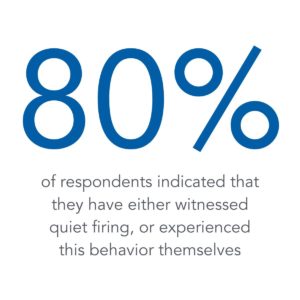
But while employers are looking more closely at employees who strictly follow through on the bare minimum, employees are bringing another buzzword to the table, and this one shifts the focus from employee behaviors to the employer’s.
Quiet Firing.
BANKW Staffing sat down with Dave Turano, Founder of JCE Consulting and Host of Cut Through the Noise Podcast, to discuss the correlation between these conjoined topics and discover what employers can do to mitigate the negative backlash of quiet firing.
What is Quiet Firing?

Whether consciously delivered or not, quiet firing is a practice designed to make an employee feel uncomfortable, unwanted, and unvalued.
On this note, Dave Turano commented, “Quiet firing starts at the top. It’s a direct result of failing to execute on a problem in real-time and can contaminate the team.” He added, “It is a passive aggressive way of companies washing their hands of responsibility and saying, ‘we didn’t do that’.”
Not New, But Increasingly Detrimental
Like quiet quitting, quiet firing is not a new concept in the business world, though it may have a direct impact on the quiet quitting trend that is stoking debates on every social media platform. This ethical conundrum has divided the spectrum in two: Those who say the employee probably earned the lack of recognition or advancement by being a poor performer, and those who say the employee’s substandard performance is a direct result of being subjected to, or witnessing, quiet firing.

Leaders Not Managers
It’s clear that there is an irrefutable link between the negative employee trend of quiet quitting and the passive-aggressive management technique of quiet firing – all of which could be a result of lacking leadership training at the management level. As is typical in many organizations, managers can organize and direct a team while leaders can inspire and develop their teams to be better. It is apparent that closing the gap between managers and leaders and instilling a deeper capacity for leadership in all levels of management can create a more inspired and engaged employee base from top to bottom.
Founder of JCE Consulting, Dave Turano advised that leaders must look in the mirror and ask themselves why. Not only why they perform their roles, but perhaps why they attained that role in the first place. Was it for the money? Management positions should be about leading, developing, and retaining talent.
“A good manager is a master of understanding themselves in order to understand others and forge real relationships,” Dave stated. He concluded simply, “If the people around you aren’t better because of you, then you aren’t needed.”
Stop Quiet Firing to Stop Quiet Quitting
It all comes down to a lack of transparency and communication. Dave Turano continued to explain the correlation between quiet firing and quiet quitting. “Ideally, people go into a line of work because they love it, and as a result they go above and beyond for the role. It’s only when an employee feels dismissed, overlooked, or unheard that they begin to say, ‘I’m going to establish boundaries with my functions,’ a.k.a. quiet quitting.”
Managers need to be cognizant of gaslighting employees, that is, saying all is well when there is clear room for immediate performance improvements. “Communication is a result of psychological safety,” Dave Turano says. “Managers afraid of further attrition won’t address issues in real-time.” He continues, “Grey areas of expectation make those grey areas unenforceable. To mitigate quiet firing, managers and leaders need to say what they’re not saying and address the unspoken tension in a situation in order to diffuse it.”
What Can Be Done
Quiet firing starts at the top. Organizations must shift their perspective inwards to combat this toxic workplace trend. Identify areas in your organization with concerning attrition rates and examine whether this turnover was avoidable and if it was a direct result of missing leadership qualities in management. There will always be employees who try to take advantage of the redefined workplace model in these unprecedented times, however, ensuring that person isn’t a manager causing further detriment to your teams may be more critical than one may initially think.
Managers looking to improve their transparency and communication with their teams will likely see shifts in attitude, productivity, and ambition to advance. Demonstrating the following may help leaders mitigate quiet firing, and thus quiet quitting in turn.
- Don’t Rush to Solve
All problems should be addressed in real-time but logical and emotional reactions produce vastly different outcomes. When emotions are running high, don’t rush to solve a problem. Acknowledge that a conversation must be had, allow the dust settle and then actively incorporate all involved parties into a resolution discussion to be certain that everyone is well-informed of the outcome. Be sure expectations are clearly established at the end of the meeting so that there is no room for miscommunications at a later date. The last thing you want is to have these discussions again, as it says to your staff that nothing was really implemented the first time. - Avoid Letting Things Fester
Failure to address an issue in the moment can produce a snowball effect with this employee and potentially extends to their team if they observe that employee’s behavior. Consider that addressing an issue belatedly reflects poorly on the manager, not the employee, as behaviors and performance cannot be corrected until they’re confronted. The idea of “building a case” against an employee by failing to challenge problematic behaviors only demonstrates to your employees that you would rather terminate someone after-the-fact rather than proactively coaching and developing your teams. - Call Out the Unspoken
Ask yourself what conversations you’ve had with your staff as well as what conversations you haven’t had. Sometimes the unspoken issues are the ones that cause the most tension. By asking yourself what you have and haven’t done to serve your team, you can identify areas of shortcomings in yourself as well as your team, and team dynamic. Consider that as a manager, you’re likely unaware of all employee-to-employee interactions and conversations. What you’re not saying is something they certainly have taken note of and are likely discussing themselves. Control the narrative by confronting it.
Quiet Firing isn’t Quiet
Remember that these issues are highly-observable by your employees even if you aren’t hearing the conversations about it. Quiet firing is anything but quiet and will ultimately cause a ripple effect of hostility and negligence among your staff. To mitigate employees participating in the quiet quitting trend, eliminating counterproductive, and potentially toxic, management behaviors from the workplace is key.
Start by establishing transparent communications with your staff and ensuring that employees feel safe enough in their roles and futures to be honest with you about their goals, issues, and shortcomings. The challenging discussions are often the ones that will produce the most significant impacts on your team, so be certain to address those unspoken items that have your team walking on eggshells. Ensure that discussions come to actionable and measurable resolutions by which to gauge progress and survey your team for additional feedback regularly.
The disconnect between employees and managers is a gap that will not be bridged by ignoring it, but by continuing to foster environments of inclusivity, growth, and innovation.
About BANKW Staffing
Through its portfolio companies, KBW Financial Staffing & Recruiting, Alexander Technology Group, The Nagler Group, Sales Search Partners, and KNF&T Staffing Resources, BANKW Staffing, LLC is the leading regional provider of temporary and direct-hire staffing services in the areas of finance, accounting, information technology, office and administration, legal, human resources, and sales.
BANKW Staffing companies have received over 100 awards for rapid growth, business excellence, and workplace quality. Recognition includes Inc. 500, Boston Business Journal’s “Best Places to Work” and Business NH Magazine’s “Business of the Year”.
Learn More – https://www.bankwstaffing.com
Media Contact
Please send media requests to pr@wordpressmu-915361-3242143.cloudwaysapps.com or contact us directly at 603-637-4500.


